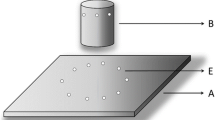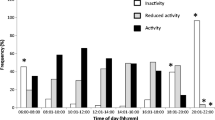Abstract
Mating and oviposition rhythms and evidence for sex-specific pheromones of the gray-black citrus longicorn beetle Nadezhdiella cantori were investigated. The reproductive and flight activities of this insect mainly occurred between 1700 and 2400 h, and each activity had two peaks with the first one taking place within the 3 h before sunset (2100 h) and the second occurring within the 3 h after sunset. Circadian rhythms of mating and oviposition were significantly correlated but neither mating nor oviposition was significantly correlated with flight. It is suggested that mating and oviposition repeat in turn during pair-bonding and that flight is an indication of termination of reproductive activities in some individuals of a population. Males differentiated between sexes by touching. Mating behavior of males was stimulated by a contact female sex pheromone on the female body surface. Fighting behavior of males was mediated by a chemical on the male body surface. Females left trails of the contact sex pheromone on the trees when walking, which males used to locate them. Implications of these findings are discussed.
Similar content being viewed by others
REFERENCES
Akutsu, K., and Kuboki, M. (1983a). Mating behavior of the udo longicorn beetle, Acalolepta luxuriosa Bates (Coleoptera: Cerambycidae). Jpn. J. Appl. Entomol. Zool. 27: 189–196 (in Japanese).
Akutsu, K., and Kuboki, M. (1983b). Analysis of mating behavior of the udo longicorn beetle, Acalolepta luxuriosa Bates (Coleoptera: Cerambycidae). Jpn. J. Appl. Entomol. Zool. 27: 247–251 (in Japanese).
Alcock, J. (1994). Postinsemination associations between males and females in insects: The mate-guarding hypothesis. Annu. Rev. Entomol. 39: 1–21.
Chang, S., Shen, Y., and Si, Y. (1963). Studies on the citrus trunk cerambycid, Nadezhdiella cantori Hope. Acta Phytophyl. Sin. 2: 167–172 (in Chinese).
Duffy, E. A. J. (1968). A Monograph of the Immature Stages of Oriental Timber Beetles (Cerambycidae). British Museum (Natural History), London.
Fauziah, B. A., Hidaka, T., and Tabata, K. (1987). The reproductive behavior of Monochamus alternatus Hope (Coleoptera: Cerambycidae). Appl. Entomol. Zool. 22: 272–285.
Fauziah, B. A., Tabata, K., Ito, K., Takahashi, S., and Hidaka, T. (1992). Mating behavior of the cryptomeria bark borer, Semanotus japonicus Lacordaire (Coleoptera: Cerambycidae). Appl. Entomol. Zool. 27: 19–30.
Fukaya, M., and Honda, H. (1992). Reproductive biology of the yellow-spotted longicorn beetle, Psacothea hilaris (Pascoe) (Coleoptera: Cerambycidae): I. Male mating behaviors and female sex pheromones.Appl. Entomol. Zool. 27: 89–97.
Fukaya, M., Akino, T., Yasuda, T., Tatsuki, S., and Wakamura, S. (1999). Mating sequence and evidence for synergistic component in female contact sex pheromone of the whitespotted longicorn beetle, Anoplophora malasiaca (Thomton) (Coleoptera: Cerambycidae). Entomol. Sci. 2: 183–187.
Goldsmith, S. K. (1987). The mating system and alternative reproductive behaviors of Dendrobias mandibularis (Coleoptera: Cerambycidae). Behav. Ecol. Sociobiol. 20: 111–115.
Goldsmith, S. K., Stewart, Z., Adams, S., and Trimble, A. (1996). Body size, male aggression, and male mating success in the cottonwood borer, Plectrodera scalator (Coleoptera: Cerambycidae). J. Insect Behav. 9: 719–727.
Gressitt, J. L. (1942). Destructive long-horned beetle borers at Canton, China. Spec. Publ. Lingnan Nat. His. Surv. Mus. 1: 1–60.
Grodnitskii, D. L. (1988). Behavior of longicorn beetles Monochamus Guer. (Coleoptera: Cerambycidae) when searching for a female. Lesovendenie 1: 74–76 (in Russian).
Hanks, L.M. (1999). Influence of the larval host plant on reproductive strategies of cerambycid beetles. Annu. Rev. Entomol. 44: 483–505.
Hanks, L. M., Millar, J. G., and Paine, T. D. (1996a). Body size influences mating success of the eucalyptus longhorned borer (Coleoptera: Cerambycidae). J. Insect Behav. 9: 369–382.
Hanks, L. M., Millar, J. G., and Paine, T. D. (1996b). Mating behavior of the eucalyptus longhorned border (Coleoptera: Cerambycidae) and the adaptive significance of long “horns”. J. Insect Behav. 9: 383–393.
He, P. and Huang, J. F. (1993). Adult behaviour of Anoplophora glabripennis.Acta Entomol. Sin. 36: 51–55 (in Chinese).
Hollander, M. and Wolfe, D. A. (1999). Nonparametric statistical methods, 2nd ed., JohnWiley & Sons, New York.
Hua, L. Z. (1982). A Checklist of the Longicorn Beetles of China (Coleoptera: Cerambycidae). Zhongshan University Press, Guangzhou (in Chinese).
Hughes, A.L. (1981). Differential male mating success in the white spotted sawyerMonochamus scutellatus (Say) (Coleoptera: Cerambycidae). Ann. Entomol. Soc. Am. 74: 180–184.
Iwabuchi, K. (1985). Mating behaviour of Xylotrechus pyrrhoderus Bates (Coleoptera: Cerambycidae). II. Female recognition by male and the existence of a female sex pheromone. Appl. Entomol. Zool. 20: 416–423.
Iwabuchi, K. (1988). Mating behaviour of Xylotrechus pyrrhoderus Bates (Coleoptera: Cerambycidae). VI. Mating system. J. Ethol. 6: 69–76. Circadian Rhythms and Pheromones of Nadezhdiella cantori 539
Kim, G. H., Takabayashi, J., Takahashi, S., and Tabata, K. (1992). Function of pheromones in mating behaviour of the Japanese pine sawyer beetle, Monochamus alternatus Hope. Appl. Entomol. Zool. 27: 489–497.
Kim, G. H., Takabayashi, J., Takahashi, S., and Tabata, K. (1993). Function of contact pheromone in the mating behaviour of the cryptomeria bark borer, Semanotus japonicus Lacordaire (Coleoptera: Cerambycidae). Appl. Entomol. Zool. 28: 525–535.
Kuboki, M., Akutsu, K., Sakai, A., and Chuman, T. (1985). Bioassay of the sex pheromone of the udo longicorn beetle, Acalolepta luxuriosa Bates (Coleoptera: Cerambycidae). Appl. Entomol. Zool. 20: 88–89.
Lieu, K. O. V. (1947). The study of wood borers in China. 2. Biology and control of the citrustrunk cerambycid, Nadezhdiella cantori (Hope) (Coleoptera). Notes Entomol. Chin. 11: 69–119.
McCauley, D. E., and Lawson, E.C. (1985). Mating reduces predation on male milkweed beetles. Am. Nat. 127: 112–117.
Parker, G. A. (1970). The reproductive behaviour and the nature of sexual selection in Scatophaga stercoraria L. (Diptera: Scatophagidae). VII. The origin and evolution of the passive phase. Evolution 24: 774–788.
Wang, Q. (1998). Evidence for a contact female sex pheromone on Anoplophora chinensis (Forster) (Coleoptera: Cerambycidae: Lamiinae). Coleopts Bull. 52: 363–368.
Wang, Q., Zeng, W. Y., and Li, J. S. (1990). Reproductive behaviour of Paraglenea fortunei (Coleoptera: Cerambycidae). Ann. Entomol. Soc. Am. 83: 860–866.
Wang, Q., Li, J. S., Zeng, W. Y and Yin, X. M. (1991). Sex recognition by males and evidence for a female sex pheromone in Paraglenea fortunei (Coleoptera: Cerambycidae). Ann. Entomol. Soc. Am. 84: 107–110.
Wang, Q., Chen, L.Y., Zeng, W.Y., and Li, J. S. (1996a). Reproductive behavior of Anoplophora chinensis (Forster) (Coleoptera: Cerambycidae: Lamiinae), a serious pest of citrus. Entomol. (London) 115: 40–49.
Wang, Q., Chen, L. Y., Li, J. S., and Yin, X. M. (1996b). Mating behavior of Phytoecia rufiventris Gautier (Coleoptera: Cerambycidae). J. Insect Behav. 9: 47–60.
Wang, Q., Shi, G. L., and Davis, L. K. (1998). Reproductive potential and daily reproductive rhythms of Oemona hirta (Coleoptera: Cerambycidae). J. Econ. Entomol. 91: 1360–1365.
Author information
Authors and Affiliations
Corresponding author
Rights and permissions
About this article
Cite this article
Wang, Q., Zeng, W., Chen, L. et al. Circadian Reproductive Rhythms, Pair-Bonding, and Evidence for Sex-Specific Pheromones in Nadezhdiella cantori (Coleoptera: Cerambycidae). Journal of Insect Behavior 15, 527–539 (2002). https://doi.org/10.1023/A:1016333317564
Issue Date:
DOI: https://doi.org/10.1023/A:1016333317564




